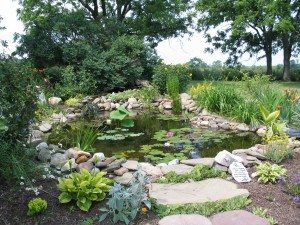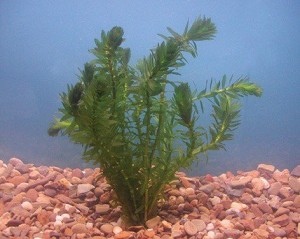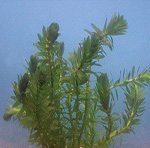Woke up this morning with a chill in the air....gone for a few days are the 80 degree temps. This is what we woke up to this morning.
The leaves are even beginning to fall with the wind blowing. I guess we all know what is in store for us for the next couple months.
Another Red Scarf bud is starting to open in my pond. I find I enjoy the pond plants even more towards the end of the season. It's such a pretty lotus bud.
I probably should get out my sweatshirts and sweaters now. I love fall with its beautiful colors when the leaves begin to turn but don't look forward to what comes after....snow. There are a few things we can start doing to our ponds now since the days are numbered. Here's a list of some fall and winter pond plant care items for the hardy pond plants.
HARDY WATER LILIES
With the lower temperatures during the fall season, you will notice a decrease in water lily blooms and the lily pads turning yellow as the water temperatures cool. It is important at this time to remove the dead leaves and spent blooms to avoid having the debris in the pond over winter. As winter approaches and water temperatures drop, the water lily will go dormant. Remove all dead lily pads and lower the potted lily to the deepest part of the pond or to a water depth of about two feet.
SUBMERGED PLANTS
As long as the submerged plants are below the ice, they will usually survive the winter. Any part of the plant that is allowed to freeze will turn to mush and add unwanted debris to the pond. It is wise to cut these plants back and sink below the surface.
HARDY BOG/MARGINAL PLANTS
Once your hardy marginal plants begin to brown, usually after the first hard frost, prune back excess foliage and discard any decaying material, so it does not compromise the water quality over the winter months. Potted bog plants such as Pickeral and Thalia Dealbata should be placed at a sufficient depth to avoid freezing the crown of the plant. Plants such as Japanese Variegated Iris and Cardinal Flower should be removed from the pond and planted in the yard for the winter. When new growth begins in the Spring, they can be placed back in the pond for the summer. Most of the other hardy bog plants can be left as they are and will return the following spring.
 Its essential to achieve a natural ecological balance in your pond. We can achieve this naturally with a few key steps. Adding submerged plants play an important role in achieving success by removing excessive nutrients in the water and provide oxygen during the day for fish and other aquatic creatures. The most important role is removing excessive nutrients that help reduce the incidence of algae which is the nightmare of most water gardeners. They starve out the algae by utilizing all the mineral salts which the algae normally feeds from.
Its essential to achieve a natural ecological balance in your pond. We can achieve this naturally with a few key steps. Adding submerged plants play an important role in achieving success by removing excessive nutrients in the water and provide oxygen during the day for fish and other aquatic creatures. The most important role is removing excessive nutrients that help reduce the incidence of algae which is the nightmare of most water gardeners. They starve out the algae by utilizing all the mineral salts which the algae normally feeds from.
Submerged pond plants oxygenate the water during the day, but at night the process is reversed and carbon dioxide is produced. This only becomes a problem if your night time temperatures are quite warm and you overstock your pond with fish. Generally the more submerged plants you put in your pond the better the pond balance will be.
Algae likes full sunlight so in addition to the submerged plants add floating plants, waterlily foliage or bog plants to cover at least one third to one half of your pond's surface, but no more than one half to be successful in controlling the green suspended algae.
There is a balance to achieve so make sure you don't cover too much of your ponds surface with plants or it will inhibit the submerged plants from growing.
The recommendation is to have 1 bunch of submerged plants per every 2 to 3 square feet of surface area. We sell submerged plants by the bunch so you receive 6-8 plants per bunch. You can determine your surface area by multiplying your length by the width of your pond. This gives you a general idea.
A similar calculation is made to determine the quantity of floating plants and waterlilies for your pond. Determine the square footage and remember you don't want more than half of the surface covered so that the submerged plants receive plenty of light.
Once you create the formula for water clarity the rest is easy.
 As long as the submerged plants are below the ice, they will usually survive the winter in most zones. Any part of the plant that is allowed to freeze will turn to mush and add unwanted debris to the pond. It is wise to cut these plants back.
As long as the submerged plants are below the ice, they will usually survive the winter in most zones. Any part of the plant that is allowed to freeze will turn to mush and add unwanted debris to the pond. It is wise to cut these plants back.
There are five different types of plants that you will want to add to your pond to provide beauty and help you achieve an ecological balance in your water garden.
Submerged plants such as Anacharis, Vallisneria, Cabomba, Hornwort and Red Ludwigia remove nutrients from the water so algae can’t thrive. Submerged plants do not need soil. Just plant them in one-gallon pots or plant baskets filled with pea gravel and place them in the bottom of your pond. Or purchase plant anchors with your plant order, and simply wrap the weights around the bunch of plants and they will sink to the bottom of the pond.
Water Hyacinth, Water Lettuce, Frog Bit, Parrot’s Feather and Azolla are all members of the floating plant family. Floating plants are very useful in keeping the pond water clean and clear. These are simple plants that free-float and do not need to be potted. You simply toss them into the water garden where they are extremely beneficial to the pond. Floating plants shade the surface and with their roots dangling in the water they pull nutrients from the water essentially starving the algae. They tend to be quite prolific and provide hiding places for baby fish and other water garden inhabitants.
Otherwise known as water lilies, they grow in pots placed 12 to 36 inches deep and have foliage and flowers that bloom on top of the water’s surface. Water lilies provide shade for the fish and add coverage to the water’s surface. Water lilies are available in many different colors and sizes.
Lotus are also considered a hardy water plant that can also be planted deep in your pond and its flowers and leaves will help provide shade and coverage.
Plants such as the hardy canna (Thalia dealbata) grow in mud or 8 to 12 inches deep in the water. Arrange them on platform shelves on the edge of your pond to conceal the water garden’s artificial edges. Plant bog and marginal plants in plastic pots, then place the pot under the water and let the plants grow in the open air. When the plants are young, use care and gradually lower them deeper as the plant matures.
Bog Plants and Marginal Plants
Marginal and bog plants grow in damp soil just outside a pond. They are good transition plants between land and water. Some tolerate completely waterlogged ground and others will not tolerate more than moist soil, check each plant’s requirements carefully.
 Anacharis (Elodea canadensis) is a submerged plant or oxygenator. All ponds should have submerged plants to aid in maintaining clean and pure water. They help prevent algae growth. Anacharis grows in sun and shade and can be in water 1-10 feet deep. Each pond plant only spreads to about 12 inches. Anacharis will often overwinter outdoors in your pond successfully in zone 5 and above. You would need to cut it back to below the freeze line. It is a good underwater plant for removing phosphates from your pond water. The submerged plants can be potted in one gallon containers with pea gravel to hold them in place or they can be weighted and dropped to the bottom of your water garden. Completely submerged these plants to a depth of at least 12 inches.
Anacharis (Elodea canadensis) is a submerged plant or oxygenator. All ponds should have submerged plants to aid in maintaining clean and pure water. They help prevent algae growth. Anacharis grows in sun and shade and can be in water 1-10 feet deep. Each pond plant only spreads to about 12 inches. Anacharis will often overwinter outdoors in your pond successfully in zone 5 and above. You would need to cut it back to below the freeze line. It is a good underwater plant for removing phosphates from your pond water. The submerged plants can be potted in one gallon containers with pea gravel to hold them in place or they can be weighted and dropped to the bottom of your water garden. Completely submerged these plants to a depth of at least 12 inches.
Buy Anacharis - Submerged Pond Plants here.